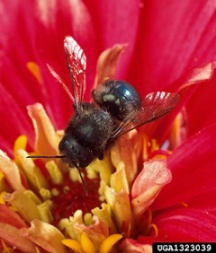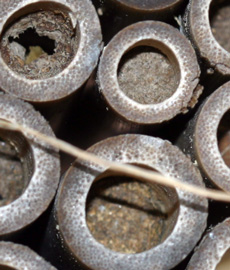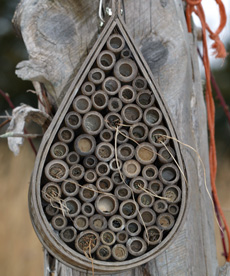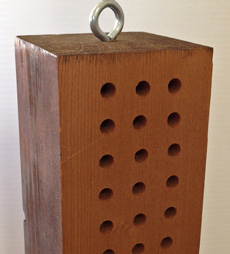Who are they?
They are great little native bees called orchard mason bees or blue orchard bees (Osmia lignaria) and they are one of the most prolific pollinators of early spring flowers. These bees, which are native to the US, are solitary bees. They don’t have a complex social system or live in hives like the European honeybees. They are loners that keep to themselves and do not interact with other bees except when they mate.
Everything about these mason bees, including their life cycle and their nesting habits are very similar to the two other solitary bee species I have written about; ground bees and carpenter bees.
The major difference is that mason bees do not excavate their own nesting cavities. While the carpenter bees chew perfectly round nesting tunnels in wood and ground bees excavate nesting sites in the ground, mason bees make use of pre-existing holes and cavities. They will use holes left behind by wood boring insects, holes drilled by woodpeckers, and sometimes they make their nests in hollow stems.
Orchard mason bees emerge from their nests in the early spring. Male bees emerge first because the eggs that are destined to become males are laid in the front part of the tube and the eggs that will become females are laid towards the back. When the female mason bees emerge, they mate and then hunt around for a suitable nesting site. Once they find a good place, they collect pollen and nectar from nearby spring flowers and deposit it in the back of the nesting hole. When a sufficient quantity of pollen and nectar has been collected, a single egg is laid on the pollen ball and a plug of mud (this is where they get the name mason bee) is used to partition off the cell. This continues until the tunnel is filled with separate cells of pollen balls and eggs. The hole is then sealed with a final plug of mud.
When the eggs hatch, the larvae feed on the pollen ball over the summer months and then eventually pupate. The adult bees develop in the pupal case but remain dormant in their individual cells through the winter. They emerge from the nest when the weather warms in the spring.
Like many species of solitary bees, mason bees are very docile and not prone to aggressiveness. The males do not possess a stinger so they can’t sting and the females will only sting if they are handled roughly or really provoked. Thus, they are wonderful bees to have around in the garden.
Since mason bees are such great pollinators, many gardeners and home orchardists will place artificial mason bee houses around their gardens or fruit trees in order to encourage them to nest there. This can help ensure good pollination of spring blooming trees, shrubs, and flowers.
Several years ago, my sister gave us a very attractive mason bee house which we placed on a post in our little orchard. Every year most of the tubes are occupied by mason bees. Yay for us!
When I was up in the orchard a few days ago, I noticed that there were several nests of woven grass in some of the tubes of our mason bee house and I was curious about who had built them. I didn’t think that mason bees ever used grass to plug their nest holes. It turns out that a solitary wasp called a grass-carrying wasp (Isodontia sp.) sometimes makes nests in mason bee houses. These wasps line their nests with grass and provision them with crickets or katydids for the developing larvae to feed on rather than making pollen balls as the mason bees do. Interesting!
Now is a great time to put up some mason bee houses in your garden or orchard. These perky little pollinators will be emerging soon and they might just stick around to pollinate your early spring flowers if they find a vacant “hotel” nearby!
You can even make your own by drilling 5/16″ holes on 3/4″ centers in a block of untreated wood. The holes should be drilled at least 4″ deep depending on the depth of your block of wood. Just make sure you don’t drill all the way through the block – leave about 1/2″ of wood at the back.





